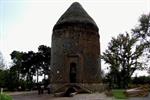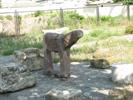Barda is the capital city of the Barda Rayon in Azerbaijan, located south of Yevlax and on the left bank of the Terter river. Once an Armenian town, and later the capital of Caucasian Albania perhaps since the end of the fourth century, Barda became the chief city of the Islamic province of Arran, the classical Caucasian Albania, remaining so until the tenth century. Like Qabala and Shamakha, Barda was a major city for over a millennium.
For most of the 'Albanian' period Barda (known then as Partav) was politically subservient to Qabala, though it took at least one turn as capital after Qabala effectively collapsed during the 6th century Mekhrane dynasty. Wall fragments of the Torpaq Qala (Earthen Castle) are held to date from this era. Nonetheless, Barda was foremost a trading centre whose importance was cultural and economic more than military.
In the summer of 941 Barda was an emirate loyal to the Arab Caliph when one of the bizarrest incidents in Azeri history occurred. Asmut and Svened, a pair of Viking warriors had negotiated free passage right down the Volga for them, their classic longboats and their small, private army. In a veritable Odyssey, they then traced the western shore of the Caspian and sailed up the great Kura river, finally mooring at the junction of the Tartar river.
From there they launched an audacious raid on Barda. Understandably, the locals were not exactly expecting a gang of drunk Scandinavians to roll into town and much of the town's superstitious population simply fled from what were assumed to be devils. For two months Azerbaijan was thus a nominal Norwegian colony. However, an unfamiliar surfeit of fruit soon had the invaders clinging to their medieval toilets. The Emir regrouped his forces and marched into town but the Vikings fled without a fight, apparently making it all the way home again eventually (Sources differ widely on the dates and details of these events, frequently referred to as the 'Varang Incursion' though ethnic 'Vikings', Svened and Asmut were probably from families that had settled initially in what is today's Ukraine).
What to see
The familiar teamwork of earthquakes, redevelopment and Genghis Khan have been cruel but Barda retains some intriguing hints of the town's former glory. Three brick arches (out of an original sixteen) show where a classic 120m ancient bridge once spanned the Tartar river diagonally.
Though 'restored' in the Soviet era with an unsightly concrete conical top, the brick and blue-tiled Barda Turbasi (Akhmed Zocheibana Mausoleum) is second only to Nakhchivan's Momine Khatun tower for works of this genre. Built in 1322 by Ahmed Ibn Ayyub al Hafiz, the kufic inscriptions are sadly crumbling but the tower is attractively set in a pretty rose garden in the centre of the modest mud walls of Nushaba/Torpaq Qala (supposedly 6th century). Local whitebeards claim that it once served as a keep/watch tower controlled by Dagestani princes and that a warren of unexplored tunnels lead out from beneath it.
The nearby Imamzade is an important Muslim shrine at the supposed grave of Prince Ismail, grandson of Imam Jaffar Sadiq. It had already been a place of pilgrimage for generations when 12th-century merchant, Tajir Ibrahim, decided to sponsor the brick-domed mausoleum.
The four minarets were added in 1868 by Kerbelaji Safi Khan who also built mosques in Agdam and Shusha and lived to the ripe old age of 122. Within the shrine is a stone draped with a green flag and topped with an Arab sabre. The complex is bracketed by brick and metal prayer areas, and set within a very extensive mixed (Christian and Muslim) cemetery with several other notable tombs.
Unobtrusive with a small brick dome, the Bakhman Mirza tomb was for a nephew of the Qajar Shah of Persia who was a minor poet. A curious ring of stones is all that remains of the Agastan Baba Pir, destroyed decades ago in an earthquake. The muddy mound beside it is not a kurgan tumulus but the debris from the excavations, with plentiful fragments of blue-glazed ceramics. Contemporary 'portrait' memonals include those of Shura Abbasov (shown in a traditional hat but holding his electric guitar and mobile phone) and the full colour depiction of 16-year-old Vugar Ahmadov (killed by an electric shock in a faulty sauna).
At the back of the cemetery Haji Nadit Nazarli has built his own private mini mosque, vine-shaded flower garden and little pool so that his grandchildren can swim while the family visits the clan's graves (some as yet unoccupied).










